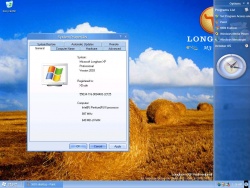Windows Longhorn/6.0.3683.Lab06 N.020923-1821: Difference between revisions
mNo edit summary |
No edit summary |
||
| Line 8: | Line 8: | ||
|bios = September 24, 2002 | |bios = September 24, 2002 | ||
}} | }} | ||
'''Windows Longhorn | '''Windows "Longhorn" 3683''' (with a build tag of '''3683.Lab06 N.020923-1821''') is a leaked build of the [[Microsoft]] [[Windows:Longhorn|Windows "Longhorn"]] operating system. Compiled on October 23, 2002, build 3683 is one of the first builds leaked to the public. Due to the operating system being so early in the development process, only a small number of changes were observed from [[Windows:XP|Windows XP]]. | ||
Features in build 3683 include the [[Windows:Visual Styles:Plex|Plex]] visual style, [[Internet Explorer|Internet Explorer 6.05]], the [[Windows:Sidebar|Windows Sidebar]], and a display settings applet based on the Windows Presentation Foundation (then codenamed ''Avalon''). | |||
Build 3683 is incompatible with a number of applications that require Windows XP or earlier. Many of these compatibility issues can be solved by running applications in Windows Compatibility Mode or by editing the ''CSDVersion'' key located in the Windows Registry. | |||
Although stable compared to later builds of | Although this build is stable when compared to later builds of "Longhorn", [[Windows Explorer]] is known to crash frequently and will occasionally fail to terminate while ending the computer session. | ||
== Gallery == | == Gallery == | ||
<gallery> | <gallery> | ||
Image:Longhorn 3683 (1).jpg|The desktop in 3683 | Image:Longhorn 3683 (1).jpg|The Windows desktop in build 3683 | ||
Image:Longhorn 3683 (2).jpg|Display Properties applet | Image:Longhorn 3683 (2).jpg|''Display Properties'' applet based on the Windows Presentation Foundation | ||
Image:Longhorn 3683 (3).jpg|The | Image:Longhorn 3683 (3).jpg|The Preview Pane in Windows Explorer | ||
Image:Longhorn 3683 (4).jpg|System Properties window | Image:Longhorn 3683 (4).jpg|''System Properties'' window and Windows Sidebar | ||
Image:Longhorn 3683 (5).jpg|Windows Explorer | Image:Longhorn 3683 (5).jpg|Windows Explorer | ||
</gallery> | </gallery> | ||
Revision as of 06:56, 14 February 2014
 |
|
| Windows "Longhorn" 6.0.3683.Lab06_N.020923-1821 | |
| Kernel version | NT 6.0 |
|---|---|
| CPU architecture | x86 |
| Edition | Client Professional |
| BIOS date | September 24, 2002 |
Windows "Longhorn" 3683 (with a build tag of 3683.Lab06 N.020923-1821) is a leaked build of the Microsoft Windows "Longhorn" operating system. Compiled on October 23, 2002, build 3683 is one of the first builds leaked to the public. Due to the operating system being so early in the development process, only a small number of changes were observed from Windows XP.
Features in build 3683 include the Plex visual style, Internet Explorer 6.05, the Windows Sidebar, and a display settings applet based on the Windows Presentation Foundation (then codenamed Avalon).
Build 3683 is incompatible with a number of applications that require Windows XP or earlier. Many of these compatibility issues can be solved by running applications in Windows Compatibility Mode or by editing the CSDVersion key located in the Windows Registry.
Although this build is stable when compared to later builds of "Longhorn", Windows Explorer is known to crash frequently and will occasionally fail to terminate while ending the computer session.
Gallery
External links
- BetaArchive Longhorn 3683 Gallery
- "Longhorn" Alpha Preview - Build 3683 reviewed by Paul Thurrott




